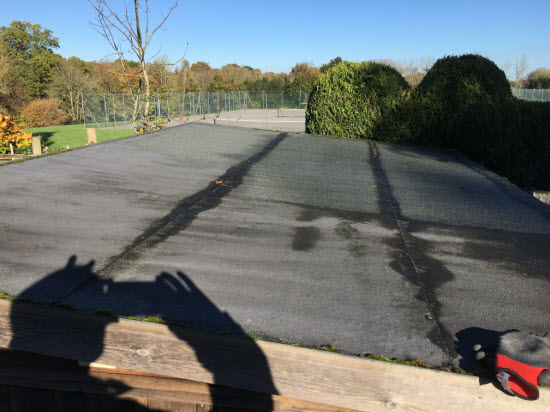Shed Roofing: Why It's Not as Obvious as It Looks
A Senior Expert... Beaten by a Shed Roof
About twenty years ago, I worked for a top-tier consulting firm. One of the senior partners - a man with a PhD, stacks of qualifications, and a reputation as a construction industry heavyweight - would regularly bring me in on expert witness cases.
So imagine my surprise when, a few years after I left and started fixing sheds for a living, I got a call from him.
'I've tried everything. This roof still leaks.'
He'd spent months battling the tired old felt on his garden shed - patching holes, re-sealing lap joints. And it still let in water.
 My ex- colleagues tired old shed roof, leaking despite his efforts
My ex- colleagues tired old shed roof, leaking despite his efforts
The problem wasn't his workmanship. It was the material. Felt was never going to hold up. What he needed - and what we installed - was an EPDM rubber membrane. It was quick, clean, and years later, it's still dry inside.
That story sums up what this page is about.
Shed roofing isn't just about plugging holes. It's about
understanding the strengths and weaknesses of the materials available - and choosing one that fits your shed, your wallet, and how long you want it to last.
Shed Roofing Materials: What Are Your Choices?
Links to each material's deep dive are included below - just click the name to learn more.
Shed Roof Felt
- Pros: Cheapest upfront cost. Easy to cut and install.
- Cons: Short lifespan (3-5 years). Tears easily. Poor in extreme weather.
Tip: Great for temporary use or where budget is the main driver - but expect to replace it often.
EPDM Rubber Roof Membrane
- Pros: Extremely long lifespan (20-50 years). Single sheet, minimal seams.
- Cons: Slightly higher material cost. Best installed in dry, mild weather.
Tip: Cost per year is unbeatable. It's the best all-round option for most sheds.
Also: How to install epdm roofing
And: Replacing shed roof felt with epdm on a small shed roof
Green Shed Roof
- Pros: Environmentally friendly, visually stunning, supports wildlife.
- Cons: Requires strong roof structure, careful planning, and a waterproof base layer.
Tip: Think of it as landscaping your roof - ideal for summerhouses, garden offices or eco-conscious builds.
Felt Shingles
- Pros: Easy and quick to install, add visual interest to a roof and they come in a variety of colours
- Cons: longer lifespan than bitumen felt but not as durable as other items on this list, don't use on slopes shallower than 17 degrees
Tip: A good budget friendly medium durability solution
Onduline Roofing
- Pros: Lightweight, quick to install, medium-cost. Decent lifespan.
- Cons: Can deform over time, especially on hot sunny slopes. Not the prettiest.
Tip: A good fit for larger utility sheds or stable-style outbuildings.
Metal Shed Roofing
- Pros: Long lifespan. Low maintenance. Modern or industrial look.
- Cons: Less forgiving if your roof isn't square. Can be noisy in rain.
Tip: Get help measuring - precision matters with metal panels.
Ecoslate
- Pros: Looks like slate. Made from recycled plastic. Fairly easy to install.
- Cons: Newer product - long-term lifespan still being proven.
Tip: Great for combining eco-values with a traditional look.
Cedar Shingles
- Pros: Beautiful finish, ages gracefully, natural insulation.
- Cons: High material cost. Time-consuming to install.
Tip: Ideal for summerhouses or feature sheds. Budget for the look.
Temporary Shed Roof Materials
- Pros: Dirt cheap. Instant coverage in emergencies.
- Cons: Not a long-term fix. Can damage shed further if left too long.
Tip: Use tarps or damp-proof membrane as a stopgap only - not a substitute for a proper roof.
So.... Which Shed Roofing Option is Right for You?
If you want the lowest possible cost and don't mind re-roofing every few years, felt might do the trick.
If you want the best value over time, EPDM is hard to beat.
If you care about looks or making your shed a real part of your garden, consider cedar shingles, ecoslate, or even a green roof.
And if you just need something to tide you over for now - yes, the tarpaulin might save the day (but don't get too attached).
Want It Done for You?
If you live within 20 miles of Tunbridge Wells, I can take care of the whole thing - from roof inspection to material selection and full installation.
Get in touch here for your Tunbridge Wells shed roof quote
Let's Loop Back to That Expert
He had qualifications, decades of experience - but shed roofing wasn't his field. What he needed was knowledge of the right materials. Once he had that, the fix was simple.
And that's exactly what you've now got: a clear view of what's available, what lasts, and what suits your shed.
The next step? Choose the roof that works for your goals - and don't be afraid to ask for help if you need it.
Related posts:
- Did I say why EPDM roof membranes are so good?
- How to install felt roof shingles
- Had you considered a metal shed roof?

Keep in touch with our monthly newsletter
Shed Building Monthly




